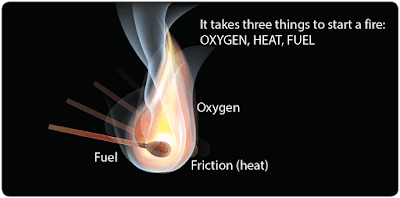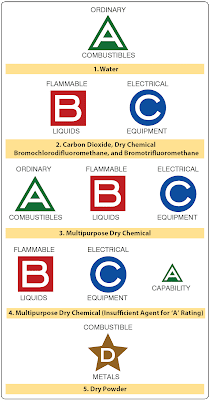Requirements for Fire to Occur
Three things are required for a fire. Remove any one of these things and the fire extinguishes:
- Fuel - combines with oxygen in the presence of heat, releasing more heat. As a result, it reduces itself to other chemical compounds.
- Heat - accelerates the combining of oxygen with fuel, in turn releasing more heat.
- Oxygen - the element that combines chemically with another substance through the process of oxidation. Rapid oxidation, accompanied by a noticeable release of heat and light, is called combustion or burning. [Figure 1]
Classification of Fires
For commercial purposes, the National Fire Protection Association (NFPA) has classified fires into three basic types: Class A, Class B, and Class C.
- Class A fires involve ordinary combustible materials, such as wood, cloth, paper, upholstery materials, and so forth.
- Class B fires involve flammable petroleum products or other flammable or combustible liquids, greases, solvents, paints, and so forth.
- Class C fires involve energized electrical wiring and equipment.
A fourth class of fire, the Class D fire, involves flammable metal. Class D fires are not commercially considered by the NFPA to be a basic type of fire since they are caused by a Class A, B, or C fire. Usually Class D fires involve magnesium in the shop, or in aircraft wheels and brakes, or are the result of improper welding operations.
Any one of these fires can occur during maintenance on or around, or operations involving aircraft. There is a particular type of extinguisher that is most effective for each type of fire.
Types and Operation of Shop and Flight Line Fire Extinguishers
Water extinguishers are the best type to use on Class A fires. Water has two effects on fire. It deprives fire of oxygen and cools the material being burned.
Since most petroleum products float on water, water-type fire extinguishers are not recommended for Class B fires. Extreme caution must be used when fighting electrical fires (Class C) with water-type extinguishers. All electrical power must be removed or shut off to the burning area. Additionally, residual electricity in capacitors, coils, and so forth must be considered to prevent severe injury or possibly death from electrical shock.
Never use water-type fire extinguishers on Class D fires. The cooling effect of water causes an explosive expansion of the metal, because metals burn at extremely high temperatures.
Water fire extinguishers are operated in a variety of ways. Some are hand pumped, while others are pressurized. The pressurized types of extinguishers may have a gas charge stored in the container with the water, or it may contain a “soda-acid” container where acid is spilled into a container of soda inside the extinguisher. The chemical reaction of the soda and the acid causes pressure to build inside the fire extinguisher, forcing the water out.
Carbon dioxide (CO2) extinguishers are used for Class A, B, and C fires, extinguishing the fire by depriving it of oxygen. [Figure 2] Additionally, like water-type extinguishers, CO2 cools the burning material. Never use CO2 on Class D fires. As with water extinguishers, the cooling effect of CO2 on the hot metal can cause explosive expansion of the metal.
When using CO2 fire extinguishers, all parts of the extinguisher can become extremely cold, and remain so for a short time after operation. Wear protective equipment or take other precautions to prevent cold injury, such as frostbite. Extreme caution must be used when operating CO2 fire extinguishers in closed or confined areas. Not only can the fire be deprived of oxygen, but so too can the operator.
CO2 fire extinguishers generally use the self-expelling method of operation. This means that the CO2 has sufficient pressure at normal operating pressure to expel itself. This pressure is held inside the container by some type of seal or frangible disk that is broken or punctured by a firing mechanism, usually a pin. This means that once the seal or disk is broken, pressure in the container is released and the fire extinguisher is spent, requiring replacement. [Figure 3]
Halogenated hydrocarbon extinguishers are most effective on Class B and C fires. They can be used on Class A and D fires, but they are less effective. Halogenated hydrocarbon, commonly called Freon™ by the industry, are numbered according to chemical formulas with Halon™ numbers.
Carbon tetrachloride (Halon 104), chemical formula CCl4, has an Underwriters Laboratory (UL) toxicity rating of 3. As such, it is extremely toxic. [Figure 4] Hydrochloric acid vapor, chlorine, and phosgene gas are produced whenever carbon tetrachloride is used on ordinary fires. The amount of phosgene gas is increased whenever carbon tetrachloride is brought in direct contact with hot metal, certain chemicals, or continuing electrical arcs. It is not approved for any fire extinguishing use. Old containers of Halon 104 found in or around shops or hangars should be disposed of in accordance with Environmental Protection Agency (EPA) regulations and local laws and ordinances.
| Group | Definition | Examples |
|---|---|---|
| 6 (Least toxic) | Gases or vapors in concentrations up to 20% by volume, for durations of exposure of up to approximately 2 hours, do not appear to produce injury | Bromotrifluoromethane (Halon 1301) |
| 5a | Gases or vapors much less toxic than Group 4, but more toxic than Group 6 | Carbon dioxide |
| 4 | Gases or vapors in concentrations of the order of 2 to 2 ½%, for durations of exposure of up to approximately 2 hours are lethal or produce serious injury | Dibromodifluormethane (Halon 1202) |
| 3 | Gases or vapors in concentrations of the order of 2 to 2 ½%, for durations of exposure of the order of 1 hour are lethal or produce serious injury | Bromochloromethane (Halon 1011) Carbon tetrachloride (Halon 104) |
| 2 | Gases or vapors in concentrations of approximately ½ to 1%, for durations of exposure of up to approximately ½ hour are lethal or produce serious injury | Methyl bromide (Halon 1001) |
Figure 4. Toxicity table
Methyl bromide (Halon 1001), chemical formula CH3Br, is a liquefied gas with a UL toxicity rating of 2. It is very toxic and corrosive to aluminum alloys, magnesium, and zinc. Halon 1001 is not recommended for aircraft use. Chlorobromomethane (Halon 1011), chemical formula CH2ClBr, is a liquefied gas with a UL toxicity rating of 3. Like methyl bromide, Halon 1011 is not recommended for aircraft use. Dibromodifluoromethane (Halon 1202), chemical formula CBr2F2, has a UL toxicity rating of 4. Halon 1202 is not recommended for aircraft use.
Bromochlorodifluoromethane (Halon 1211), chemical formula CBrClF2, is a liquefied gas with a UL toxicity rating of 5. It is colorless, noncorrosive, and evaporates rapidly leaving no residue. It does not freeze or cause cold burns and does not harm fabrics, metals, or other materials it contacts. Halon 1211 acts rapidly on fires by producing a heavy blanketing mist that eliminates oxygen from the fire source. More importantly, it interferes chemically with the combustion process of the fire. Furthermore, it has outstanding properties in preventing re-flash after the fire has been extinguished.
Bromotrifluoromethane (Halon 1301), chemical formula CF3Br, is also a liquefied gas and has a UL toxicity rating of 6. It has all the characteristics of Halon 1211. The significant difference between the two is Halon 1211 forms a spray similar to CO2, while Halon 1301 has a vapor spray that is more difficult to direct.
Note: The EPA has restricted Halon to its 1986 production level due to its effect on the ozone layer.
Dry powder extinguishers, while effective on Class B and C fires, are best for use on Class D fires. The method of operation of dry powder fire extinguishers varies from gas cartridge charges, stored pressure within the container that forces the powder charge out of the container, to scooping pails or buckets of the powder from large containers or barrels to toss on the fire.
Dry powder is not recommended for aircraft use, except on metal fires, as a fire extinguisher. The leftover chemical residues and dust often make cleanup difficult and can damage electronic or other delicate equipment.
Inspection of Fire Extinguishers
Fire extinguishers need to be checked periodically utilizing a checklist. If a checklist is unavailable, check the following as a minimum:
- Proper location of appropriate extinguisher
- Safety seals unbroken
- All external dirt and rust removed
- Gauge or indicator in operable range
- Proper weight
- No nozzle obstruction
- No obvious damage
Airport or other local fire departments can usually help in preparing or providing extinguisher checklists. In addition, these fire departments can be helpful in answering questions and assisting in obtaining repairs to or replacement of fire extinguishers.
Identifying Fire Extinguishers
Fire extinguishers are marked to indicate suitability for a particular class of fire. The markings on Figure 5 must be placed on the fire extinguisher and in a conspicuous place in the vicinity of the fire extinguisher. When the location is marked, however, take extreme care to ensure that the fire extinguisher kept at that location is in fact the type depicted by the marking. In other words, if a location is marked for a Class B fire extinguisher, ensure that the fire extinguisher in that location is in fact suitable for Class B fires.
Markings must be applied by decalcomanias (decals), painting, or similar methods. They are to be legible and as durable as necessary for the location. For example, markings used outside need to be more durable than those in the hangar or office spaces.
When markings are applied to the extinguisher, they are placed on the front of the shell, if one is installed, above or below the extinguisher nameplate. Markings must be large enough and in a form that is easily seen and identifiable by the average person with average eyesight at a distance of at least 3 feet.
When markings are applied to wall panels, and so forth, in the vicinity of extinguishers, they must be large enough and in a form that is easily seen and identifiable by the average person with average eyesight at a distance of at least 25 feet. [Figure 6]
Using Fire Extinguishers
When using a fire extinguisher, ensure the correct type is used for the fire. Most extinguishers have a pin to pull that allows the handle to activate the agent. Stand back 8 feet and aim at the base of the fire or flames. Squeeze the lever and sweep side to side until the fire is extinguished.





